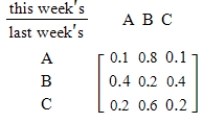Multiple Choice
A local business A has two competitors, B and C. No customer patronizes more than one of these businesses at the same time. Initially, the probabilities that a customer patronizes A, B, or C are 0.2, 0.6, and 0.2, respectively. Suppose A initiates an advertising campaign to improve its business and finds the following transition matrix to describe the effect. 
Find the steady-state vector for this market-that is, the long-range share of the market that each business can expect if the transition matrix holds.
A) 
B) 
C) 
D) 
E) 
Correct Answer:

Verified
Correct Answer:
Verified
Q13: A ball is drawn from a bag
Q16: A ball is drawn from a bag
Q19: If a pair of dice, one green
Q20: Suppose a die is tossed 1500 times
Q21: Suppose a fair coin is tossed 6
Q22: In a 10-question matching test with 10
Q34: How many three-digit numbers can be formed
Q50: Five candidates for manager of a department
Q64: Suppose an ice cream store offers 36
Q109: An insurance company receives 40 claims in